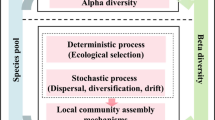Summary
The distribution pattern of ten species of Collembola was studied during the four years period from July 1971 to May 1975 in a pine forest soil.
The distribution patterns were analysed for two scales of distribution, i. e., the distribution over the plot of 10×10 m2 and the micro-distribution within a block sample consisting of 36 contigious units each 2×2 cm2 in area, by applying the\(\mathop m\limits^* \)-m regression method.
The fundamental pattern which appeared was quite similar for the species examined and individuals were aggregated in response to the heterogeneity of habitat conditions. The causes of aggregations were discussed with regard to some environmental factors.
The relative abundances of 10 species within the collembolan community was examined in relation to the habitat utilization and the relative abundance was not related to the degree of aggregation but rather to the area occupied by individuals. This suggests that the more numerically abundant species tend to occupy broader micro-habitat. Biological meaning of aggregation was discussed in connection with the population biology and community organization of collembola.
Similar content being viewed by others
References
Barra, J. A. andK. Christiansen (1975) Experimental study of aggregation during the development ofPseudosinella impediens Gisin & Gamma (Collembola, Entomobridae).Pedobiologia 15: 343–7.
Glasgow, J. P. (1939) A population study of subterranean soil Collembola.J. Anim. Ecol. 18: 323–53.
Hairston, N. G. (1959) Species abundance and community organization.Ecology 40: 404–16.
Hairston, N. G., R. W. Hill andU. Ritter (1971) The interpretation of aggregation patterns. 337–356.In G. P. Pattil, E. C. Pielou andW. E. Waters (eds.)Statistical ecology. Vol. 1. Pennsylvania Univ. Press.
Hale, W. G. (1966) A population study of moorland Collembola.Pedobiologia 6: 65–99.
Iwao, S. (1968) A new regression method for analysing the aggregation pattern in biological populations.Res. Popul. Ecol. 10: 1–20.
Iwao, S. (1972) Application of the\(\mathop m\limits^* \)-m method to the analysis of spatial patterns by changing the quadrat size.Res. Popul. Ecol. 14: 97–128.
Joosse, E. N. G. (1966) Some observations on the biology ofAnurida martima (Guérin) (Collembola).Z. Morph. Ökol. Tiere 57: 320–8.
Joosse, E. N. G. (1970) The formation and biological significance of aggregations in the distribution of Collembola.Neth. J. Zool. 20: 299–314.
Joosse, E. N. G. (1971) Ecological aspects of aggregation in Collembola.Rev. Ecol. Biol. Sol. 8: 91–7.
Kraan, C. Van Der (1971) Some aspects of field dependent distribution in a population ofHypogastura viatica Tullberg 1872.Rev. Ecol. Biol. Sol. 8: 99–102.
MacFadyen, A. (1952) The small arthropods of aMolinia fen at Cothill.J. Anim. Ecol. 21: 87–112.
MacFadyen, A. (1961) Improved funnel type extractors for soil arthropods.J. Anim. Ecol. 30: 171–84.
Milne, S. (1962) Phenology of a natural population of soil Collembola.Pedobiologia 2: 41–52.
Murphy, P. M. (1955) Note on the processes used in sampling, extraction and assessment of the meiofauna of heathland. 338–40.In D. K. McE. Kevan (ed.)Soil zoology. Butterworth Scientific Publ., London.
Niijima, K. (1975) Seasonal changes in Collembolan populations in a warm temperate forest of Japan. II. Population dynamics of the dominant species.Pedobiologia 15: 40–52.
Pomeroy, D. E. (1977) Biological studies on a peaty podzol. III. Numbers of soil living Collembola.Pedobiologia 17: 115–34.
Poole, T. B. (1961) An ecological study of the Collembola in a coniferous forest soil.Pedobiologia 1: 113–37.
Takeda, H. (1973) A preliminary study on Collembolan populations in a pine forest.Res. Popul. Ecol. 15: 76–89.
Takeda, H. (1976) Ecological studies of Collembolan populations in a pine forest soil. I. The life cycle and population dynamics ofTetracanthella sylvatica Yosii.Rev. Ecol. Biol. Sol. 13: 117–32.
Takeda, H. (1978) Ecological studies of Collembolan populations in a pine forest soil. II. Vertical distribution of Collembola.Pedobiologia 18: 22–33.
Takeda, H. (1979a) Ecological studies of Collembolan populations in a pine forest soil. III. The life cycle and population dynamics of some surface dwelling species.Pedobiologia 19: 34–48.
Takeda, H. (1979b) On the extraction process and efficiency of MacFadyen’s high gradient extractor.Pedobiologia 19: 106–12.
Tamura, H. (1976) Population studies onFolsomia octoculata (Collembola, Isotomidae) in a subalpine coniferous forest.Rev. Ecol. Biol. Sol. 13: 69–91.
Usher, M. B. (1969) Some properties of the aggregations of soil arthropods: Collembola.J. Anim. Ecol. 38: 607–22.
Usher, M. B. andM. Hinder (1975) Studies of populations ofFolsomia candida (Insecta; Collembola). The cause of aggregations.Pedobiologia 15: 355–63.
Usher, M. B. (1976) Aggregation responses of soil arthropods in relation to the soil environment.The role of terrestrial and aquatic organisms in decomposition processes. The 17 th symposium of the Britisch Ecological Society. pp 61–94.
Vannier, G. (1970)Réaction des microatthropods aux variations de l’état hydrique du sol. Edition du Centre National de la Recherche Scientifique. Programme Biologique. No 40. Paris. 319 pp.
Author information
Authors and Affiliations
Rights and permissions
About this article
Cite this article
Takeda, H. Ecological studies of collembolan populations in a pine forest soil IV. Comparison of distribution patterns. Res Popul Ecol 21, 120–134 (1979). https://doi.org/10.1007/BF02512642
Issue Date:
DOI: https://doi.org/10.1007/BF02512642




